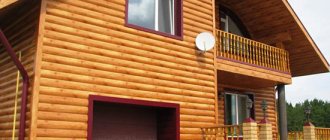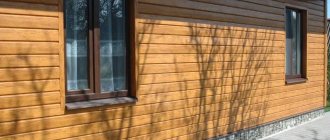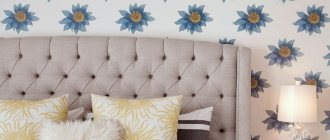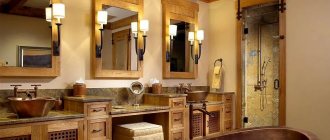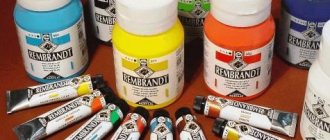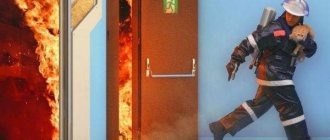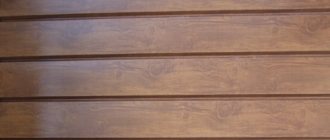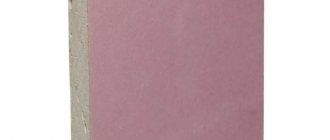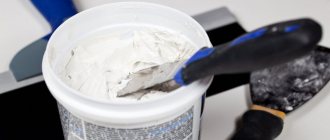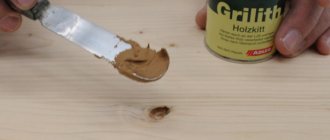Not everyone who builds their own house will choose wooden materials for its construction. Mostly houses are built from foam blocks or bricks.
However, the beauty of a house built from wood is difficult not to appreciate.
Even a house that was built from stone material can look like wood thanks to facing work using wood siding.
The varieties of this facing material are varied, as are the types of patterns and textures.
In this article we will look at wood-look siding for exterior decoration.
Wood siding - manufacturing materials
Siding is a finishing material used to cover the surface of building structures. Usually it has the form of strips 10-30 mm wide and 2-6 m long, the thickness does not exceed 10 mm. The front side can be smooth or have a relief that imitates the texture of natural materials. The inner surface, depending on the manufacturing method and material, has stiffening ribs. Also, the design includes various fasteners, locks and perforations to facilitate the installation process.
Wood-like ceramic siding cannot be distinguished from natural wood even at close range
The modern market of finishing materials offers siding made from the following raw materials:
- polymers (vinyl, acrylic);
- metal (aluminum, galvanized steel);
- fiber cement;
- ceramics;
- wood.
Let us consider each of the types of raw materials listed in more detail.
Fiber cement siding has a distinct wood grain
Vinyl
The material used to make vinyl siding is polyvinyl chloride (PVC). Depending on the area of application, it is produced in several modifications:
- Wall - product thickness no more than 3 mm. It is used for cladding facades, insulation systems or for their restoration.
- Basement - given that the cladding of the base and foundation is subject to more intense mechanical impacts, the thickness of the siding can be increased to 5 mm.
Has a wide range of colors. The outer surface can be either smooth or embossed to imitate wood texture. Can be used in a wide temperature range: -50ºС…+50ºС. The material is resistant to all types of biological and chemical corrosion. During operation it does not crack or deform. When purchasing vinyl siding, pay attention to its fireproof properties. Most modern manufacturers add fire retardant additives to their raw materials. They change the flammability class of polyvinyl chloride from G4 (highly flammable materials) to G2 (moderately flammable building materials).
Vinyl siding, timber profile (TimberBlock), Silver Oak collection
Acrylic
Acrylic siding is a relatively new type of polymer finishing material, which first appeared on the market in 2016. The raw material is acrylic-styrene compound. It is produced by extrusion followed by embossing on the front side, imitating the texture of wood. Has higher performance characteristics than vinyl. In particular, it is more resistant to extreme temperatures, does not fade under intense exposure to ultraviolet radiation, is more plastic and resistant to mechanical stress. On average, the cost of acrylic siding is 20-25% higher than vinyl, but it has improved aesthetic characteristics.
Acrylic siding can be used in the southern regions, as it is not afraid of fading
Important! Almost all manufacturers claim that the service life of plastic types of siding is 50 years. However, as practice shows, plastic finishing becomes unusable much faster due to mechanical damage.
Metal siding
The material used to make metal siding is galvanized steel or aluminum. Manufacturing is carried out by rolling method. In one pass, the product is shaped, and some manufacturers apply a relief that imitates the texture of wood. The panel thickness does not exceed 0.9 mm (mostly 0.45-0.6 mm).
Metal cladding with a block-house profile, wood imitation is achieved through coloring
The facing material is quite light, which makes it possible to do without additional reinforcement of the supporting frame. The following materials are used as an external polymer coating:
- polyester - the surface is plain, smooth, glossy or matte;
- plastisol - embossing is applied to imitate the texture of wood;
- pural - has high resistance to ultraviolet radiation (products do not fade);
- polyvinylidene fluoride (PVDF) - gives the product high resistance to most external factors and significantly increases service life.
The aluminum cladding is highly resistant to corrosion and is lightweight
Important! If for galvanized steel the external polymer coating serves to increase corrosion resistance, then a layer of polymers is applied to the aluminum base solely for aesthetic purposes - to imitate wood.
Siding based on cement mixtures
Siding based on a cement binder is also represented in two main directions:
- Fiber cement - the raw materials for production are cellulose fibers, fine sand, mineral additives and Portland cement M400-600. The texture of wood is applied to the surface. As a rule, such finishing requires additional painting. As practice shows, staining should be done once every few years. This finish is produced in the form of rectangular boards that do not have additional locking connections. Fiber cement siding is quite heavy and requires not only stronger sheathing, but also, in some cases, additional strengthening of load-bearing structures.
Finishing the extension with fiber cement panels
- Ceramic siding is the newest of all types of siding. Developed in Japan and is a material similar in its characteristics to ceramic tiles. Fiber cement mixture, kaolin clay and other modifying components are used as raw materials for production. Unlike ceramic tiles, installation is carried out using special metal holders with screws. It has almost ideal performance and aesthetic characteristics, but its cost is the highest of all the listed types of siding.
Ceramic siding panels have a high degree of imitation of natural wood
Wood
Traditional finishing materials made from solid wood are quite expensive and demanding to use. Under the influence of the environment, wood is susceptible to warping, cracking, rot, fungus, and damage by wood-boring beetles. To prevent these negative phenomena, a coating based on composite materials was developed: wood-cellulose pulp, carbide resins and polymer compounds. This type of finishing is actually made from waste from the wood industry, and therefore has a budget cost. The performance characteristics of this material are not high enough, so preference is usually given to other types of finishing.
Siding made of WPC wood-polymer composite
Related article:
Brick and stone siding : varieties, their main characteristics, advantages and disadvantages. Main manufacturers, most popular collections, sequence of installation work.
What to look for when purchasing
When purchasing material, you must consider the following parameters:
- Manufacturer . In order not to run into a fake of a fly-by-night company, you need to carefully check the information about the manufacturer of the material (read reviews on the Internet, visit thematic forums). Find out in advance from what year the company has been producing siding, in which regions it sells its material.
- Guarantee period . Serious companies provide a guarantee for their material for up to 50 years (but not less than 25 years). It is worth immediately clarifying which defects are covered by the warranty period. It must be remembered that siding, corners, trim, and flashings must be from the same manufacturer. Trying to save on component materials can void the warranty. The warranty also does not cover siding defects caused by improper installation.
- Price . The buyer must understand that high-quality material that will last for decades cannot be cheap. It is better to purchase premium products that have high-quality plasticizers and dyes, and then not worry about the strength and light fastness of the material for a long time.
It is necessary to purchase material packaged not in polyethylene, but in rigid boxes that protect it from deformation during transportation. A good manufacturer who cares about the quality of its products will never skimp on such trifles.
Main types of profiles
There are several types of siding, which are distinguished by profile shape.
- A ship plank is a profile in the form of a quadrangle, one of the ends of which is beveled at an acute angle. This form is widely used in both polymer and metal types of siding. It is distinguished by the presence of easy-to-install and sealed locking connections, which greatly facilitate the installation process. Designed for horizontal installation, which completely eliminates the penetration of moisture from rain under the coating.
Schematic representation of siding with a “ship plank” profile. Features of its installation on the work surface
- Block house (log siding) - the profile imitates the outer semicircular edge of a rounded log. This type of profile is used in metal, polymer and wood types of siding. As a rule, they try to give the cladding a look that is as close as possible to natural materials, including the texture and color of wood. Used for horizontal installation. Metal and polymer siding have locking connections and holes for fastening. The cladding made of wood composite materials is installed in a tongue-and-groove joint.
Scheme of siding with a “block house” profile and its appearance on a lined facade
- Herringbone - is a triangular profile that has a stiffening rib from an additional bend, located in such a way that two wedges are formed on one panel. Made from metal or polymers. Designed for horizontal installation. The locking connection ensures the tightness of the structure.
Herringbone profile and the appearance of siding when finishing the facade of a house
- Rectangular - a profile in the form of a simple rectangle is used in the production of fiber cement siding and ceramic siding. Fastening is carried out either directly through the cladding or using special fasteners.
Methods for attaching ceramic siding and fiber cement siding
Review of the ship plank from Grand Line
3,000 employees, 9 factories and more than 5,000 stores throughout Russia are the manufacturer of finishing materials Grand Line.
Siding logo for house trim
The company is known for its high quality, US-certified siding for home exteriors. This was achieved through quality control of raw materials and finished products. In addition, the latest materials, developments and technologies from mechanical engineering are involved in the manufacturing process.
Siding systems for home exteriors
SunproofGL system
This is resistance to aggressive solar radiation tested by numerous tests by the Grand Line team and the American concern Penn Color. The studies were carried out using Xenotest and QUV Weatherometer devices.
Vinyl siding with a unique system has been produced since 2012. During this time, many buyers and sellers were able to appreciate the development of Sunproof GL.
ShockproofGL system
Experimentation and hard work helped the Grand Line team develop a formulation for the production of panels that would make it impact-resistant. Typically, the words “impact resistance” and “vinyl siding” rarely appear in the same sentence. But not in this case.
Finishing with Shockproof GL technology is one of the few in Russia that can withstand impacts of 10 Joules at positive temperatures and 4.23 Joules at subzero temperatures.
Below are reviews of four series of shiplap siding.
Premium
The second name of the series is Grand Line D 4.4. This means that the panel has a dual configuration and a single element width of 4.4 inches. That is, the width of the entire panel will be 4.4*2=8.8 inches. This is about 224 millimeters.
Siding for exterior cladding of a house D 4.4
The Grand Line Premium collection is available in three colors:
- golden sand;
- caramel;
- dark beige.
The advantage of Premium panels is that they contain antistatic agents. This makes caring for siding for the exterior of your home even easier, because most of the dust is repelled from its surface naturally.
Tundra
The Tundra collection from Grand Line is known not only for its interesting and rich wood-look colors, but also for its 15-year guarantee for color immutability and stability, as well as 50 years for its entire service life. Color fastness is confirmed by tests in the company's own laboratory.
Sheathing a house with Grand Line Tundra siding from the Avi company
The series is similar in brightness to acrylic siding. The panels on the facade look expensive and elegant. All thanks to the unique Sunproof GL system.
The finishing is made in the best shades of trees:
- maple;
- Rowan;
- graab;
- ash.
Classic
The second title of the series is America. This siding for exterior home decoration is distinguished by a variety of colors and light weight.
In addition, the panels stand out:
- Sunproof GL and Shockproof GL systems;
- composition – components from the best European and American manufacturers are used in production;
- reliable imitation of wood pattern;
- rigid and durable lock, which ensures quick installation;
- guaranteed for 50 years against deformation and 11 years for stability of all shades.
PVC panels for home Grand Line Classic
Colors covered by warranty:
- white;
- beige;
- blue;
- cream;
- peach;
- light green;
- grey;
- Ivory;
- vanilla.
Advantages and disadvantages of use
| Parameter | Polymer siding | Metal siding | ||
| Vinyl | Acrylic | Steel | Aluminum | |
| Weight | Small | Small | Average | Average |
| Does not require reinforced sheathing or strengthening of the load-bearing structures of the structure; installation at a height of up to 2-3 floors is allowed | A reinforced (more frequent) lathing made of wooden beams with a thickness of at least 50×50 mm² is required; installation on 1-2 floors | |||
| Corrosion resistance | High | Medium, provided that the integrity of the anti-corrosion layer is maintained | High | |
| Resistance to biological corrosion | High | High | ||
| Chemical resistance | Medium, susceptible to some solvents | The base is highly resistant; the external anti-corrosion (decorative) coating can be damaged by some solvents | ||
| Fade resistant | Average | High | Medium to high, depending on manufacturer | Medium, has practically no relief texture |
| Imitation of natural materials | Average | High | Medium to high, depending on manufacturer | Medium, has practically no relief texture |
| Technological fastening and ease of installation | Fast, convenient, technological fastening | Quick fastening, reliable connection, labor-intensive cutting of material | ||
| Need for post-processing | Not necessary | |||
| Repairability | Replacement required if damaged | |||
| Price | Low | Average | Low | High |
Table continuation
| Parameter | Siding | Tree | |
| Fiber cement | Ceramic siding | ||
| Weight | Big | Big | Average |
| When covering large areas, additional strengthening of load-bearing structures is required. | |||
| Corrosion resistance | High | High | |
| Resistance to biological corrosion | If organic matter gets into cracks and grooves, moss may appear | High | Low, requires systematic treatment with antiseptic agents |
| Chemical resistance | External paintwork may be damaged | High | Average |
| Fade resistant | Average | High | Low to medium, depending on inks and primers used |
| Imitation of natural materials | High | High | |
| Technological fastening and ease of installation | Medium, the material is quite heavy | Average, despite the presence of special fasteners | Average |
| Need for post-processing | Frequency of painting: 1 time every 2-3 years | Not necessary | Recommended painting once every 1-2 years |
| Maintainability | You can cover up the damage with cement | Replacement required | You can cover up the damage with special mastic |
| Price | Average | High | Low |
Despite the big difference in basic performance characteristics, all types of siding share common positive features:
- affordable cost compared to natural materials;
- durability - service life, according to manufacturers, ranges from 25-50 years;
- environmental friendliness - even polymer sidings do not have a negative impact on human health. During operation, they do not emit carcinogenic substances, the unpleasant odor disappears some time after installation;
- The shape of the profile allows installation to be carried out quickly and without much effort, while the joints will be reliable and airtight.
Advantages and disadvantages
Like any other cladding material, siding has a number of advantages and disadvantages.
The positive characteristics of this material include:
- High quality products . Thanks to it, after finishing work, no repairs will be required for many years.
- The material can add aesthetic appeal and in some cases the appearance of the house is no different from a house built from wood.
- Siding provides a high level of protection for the walls of the house , since it is highly resistant to temperature fluctuations, mechanical damage and even scratches.
- The material is not electrically conductive.
- The panels weigh little , are flexible and do not deform even after a long period of use.
- The price level for such cladding material is acceptable.
- Siding does not require special care , and the installation process can be done with your own hands.
If a good layer of thermal insulation from a properly selected material is provided under the siding, this significantly saves money spent on heating the building.
Regarding the disadvantages, the following can be listed:
- in the event of a fire, the material is melted;
- the components needed for installation are quite expensive;
- If the house was sheathed using PVC siding, then if such a panel is damaged, it cannot be repaired. It can only be completely replaced.
Colors
Features of choice
Having analyzed the data from the table, we can come to the conclusion that the key criteria on which the choice of wood-look siding is based are the following.
- Resistance to external influences. In this case, the features of the choice of material depend on the type of external influences, that is, the location of the structure in a certain climatic zone. In the southern part of Russia, it is recommended to use siding that is resistant to high temperatures: acrylic, wood, cement-based, metal. In the northern part of the country and the Far East, the main influencing factors are low temperatures and high humidity, so it is advisable to use acrylic, metal and fiber cement sidings for cladding facades. If the structure is located by the sea or near roads with heavy traffic (high concentration of mineral salts and chemicals), it is best to use polymer sidings.
The result of the impact of hail on vinyl siding is a consequence of the use of cheap finishing materials
- Price. Even among finishing materials of the same type, the price can vary significantly depending on the manufacturer. The most expensive products are from Canada, Finland and Germany. However, the cost of products from many domestic manufacturers is much lower with a comparable level of quality.
- Durability. Under the same operating conditions, the most durable are ceramic siding, fiber cement and metal. Due to their high safety margin, they can withstand significant temperature changes, mechanical external influences and other aggressive operating factors. Polymer sidings are recommended for use in places with a low probability of mechanical impact.
Beautiful examples
Today, wood siding is traditionally used for cladding private houses and cottages. In a short time, the unpresentable appearance can be easily changed, giving the structure a laconic, strict design that remains at the peak of fashion. A rich assortment of colors and textures of materials and additional elements allows you to change the usual solutions and add a unique twist to the decoration of the facade.
- White edging on a dark wall surface will be an excellent alternative to traditional solutions.
- The cladding using dark and light tones looks unusual and elegant. For example, walls in a pleasant cappuccino color will look great with a dark frame in the color of pistachio or walnut.
It is not difficult to create an individual, extraordinary design style for your own home if you use siding with imitation wood. High-quality siding from well-known manufacturers accurately replicates the structure of wood and makes the finishing coating reliable and neat.
Installation technology
For installation work on installing siding you will need the following tools:
- level;
- roulette;
- metal scissors;
- hacksaw;
- screwdriver with attachments;
- drill (hammer);
- Bulgarian.
Depending on the type of siding, ordinary screws are used as consumables, alone or in combination with special fasteners.
Important! It is not recommended to cut polymer or metal siding with a grinder. When cutting metal, the cutting wheel heats it up, damaging the outer anti-corrosion coating. And polymers can deform under the influence of temperature.
Siding installation begins with the installation of a starting strip. It is mounted at a height of 30-40 cm from the lowest point of the house in relation to the ground level. It is necessary to set the starting bar absolutely horizontally; the quality of all work depends on this.
Installing the starting bar
If the finishing of the foundation or basement floor protrudes beyond the siding, it is imperative to install a drainage strip above the basement.
If complex additional elements are used during the installation process, they are installed in the appropriate places immediately after the starting strip is secured.
Complex additional elements
Complex additional elements and features of their installation:
- The H-connector is complex.
- The outer corner is complex.
- The internal angle is complex.
- Slope plank or platband.
- Low tide bar.
Installation of row strips can be carried out around the structure or each wall can be finished separately. An ordinary strip of siding is inserted into the vertical grooves of the additional elements and lowered onto the starting strip. It is necessary to insert it into the locking connection until it clicks. Do not use a hammer or use any other mechanical means on the siding. With the starting strip and additional elements correctly set, the row strip will fit into the locking joint quite easily.
Installation of the first row strip on the starting strip
The horizontal position is checked. Next, the strip is secured with a screw strictly in the center of the mounting holes. The sequence of fastening is from the center to the edges to prevent the formation of waves. All subsequent strips are installed in the same way.
Related article:
Do-it-yourself siding installation : instructions for dummies with photos, advantages of using panels and their varieties, tips and tricks - in our publication.
Calculator for calculating the quantity and cost of siding per house
A few simple tips for choosing
There are no universal instructions on how to choose siding for cladding a wooden house, but there are several practical tips that are worth remembering.
- Inexpensive PVC panels are suitable for a house located in the shade, but for houses in open areas it is better to take acrylic, metal or fiber cement.
- All panels must be the same color; if you see different shades, it means the material is not of high quality.
- A normal manufacturer produces an entire set of auxiliary fittings for its siding.
- A branded product must have a certificate of conformity.
- Pay attention to the packaging, a good manufacturer, in addition to polyethylene, packs its goods in cardboard boxes, and artisanal companies, at best, only seal them in polyethylene.
- Typically the warranty ranges from 20 to 50 years.
- Branded siding must be accompanied by photo instructions.
Gallery
Finishing with block house siding:
Finishing with shiplap and herringbone siding:
Finishing with ceramic siding and fiber cement siding:
What's better
First of all, it all depends on the design idea. If you want your house to look like a log house from a fairy tale, then a block house is the best choice. Raised timber looks more modern and is suitable for most style trends.
If we talk about the budget, it is not significantly different. Block house panels are a little more expensive, about 380-400 rubles per “square”. False timber for the same area will cost 290-300 rubles. Accordingly, to finish, say, 35 m2 with timber, you will have to spend 13,300 rubles, and the board will cost 10,150 rubles.
Healthy! Regardless of the type of facade panels chosen, their actual size will vary slightly due to the presence of the groove. Therefore, during the calculation process, this nuance must be taken into account.
It is impossible to say which of these two siding systems is better, since in fact they differ only in appearance. The main differences are only in the wood itself and its quality. The higher the grade, the better.
Concept of material
Before choosing wood-look metal siding for exterior decoration, you need to generally understand what material we are talking about. Not to be confused with corrugated sheeting.
This is a modern alternative to vinyl siding. With its help, residential buildings, public and industrial buildings are sheathed.
Wood-look metal siding consists of profiled panels. They are made from cold rolled steel and are also hot galvanized. To simplify installation, the design includes locks and perforated edges. There are holes for fasteners.
Due to perforation, the effect of thermal expansion is compensated.
This is a multilayer material with 4 layers:
- Steel
. This is the inner layer, which is the base. Sometimes aluminum alloy is used instead of steel; - Galvanization
. A special coating that is applied to both sides of the steel sheet. Galvanization is needed to protect against corrosion; - Primer
. Improves adhesion to the last layer and also protects the varnish on the inside of the siding; - Decorative and protective layer
. In our case, it imitates logs, timber, bleached oak and a number of other materials.
The decor is made using powder coating or polymer processing.
When choosing metal siding, I strongly recommend choosing products with a polymer coating.
But in order to save money, many manufacturers still make the inner layer using powder coating.
Types of wood siding for exterior decoration
Products of any shape can be obtained from a wood-polymer mixture, but the most popular types of wooden siding are:
- block house - lamellas that imitate a natural log house and have a convex shape;
- false beams have a flat profile and are suitable for creating perfectly smooth facades.
As for the color , it can be absolutely anything. Most buyers want to get a material that is as similar as possible to natural wood, which is why siding from light yellow to dark brown with a characteristic wooden pattern has become especially widespread. For lovers of brighter solutions, material painted in calm blue, green, white, burgundy and other shades is suitable. The technology allows you to obtain material with almost any desired appearance.
Sizes are usually standard, but many domestic manufacturers make concessions to customers by producing products to order. The length of the wooden siding board is 3, 4 or 6 m, the width can be 8-12 cm, 14-16 cm or 18-20 cm. Thickness - 1-2.1 cm.
